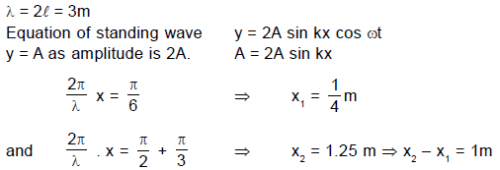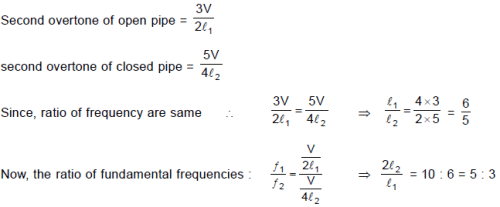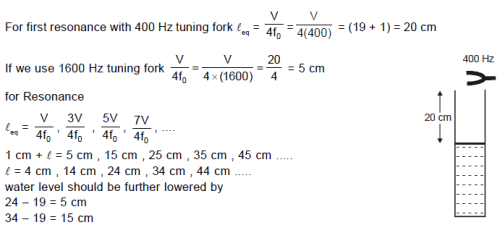JEE Advanced Test- 3 - JEE MCQ
30 Questions MCQ Test Mock Tests for JEE Main and Advanced 2025 - JEE Advanced Test- 3
A particle undergoes SHM with a time period of 2 seconds. In how much time will it travel from its mean position to a displacement equal to half of its amplitude :
A horizontal rod of mass m and length L is pivoted smoothly at one end. The rod ’s other end is supported by a spring of force constant k. The rod is rotated (in vertical plane) by a small angle q from its horizontal equilibrium position and released. The angular frequency of the
subsequent simple harmonic motion is :

subsequent simple harmonic motion is :

A traveling wave y = A sin passes from a heavier string to a lighter string. The reflected wave has amplitude 0.5 A. The junction of the strings is at x = 0. The equation of the reflected wave is:
passes from a heavier string to a lighter string. The reflected wave has amplitude 0.5 A. The junction of the strings is at x = 0. The equation of the reflected wave is:
A string of length 1.5 m with its two ends clamped is vibrating in fundamental mode. Amplitude at the centre of the string is 4 mm. Minimum distance between the two points having amplitude 2 mm is:
The average density of Earth’s crust 10 km beneath the surface is 2.7 gm/cm3. The speed of longitudnal seismic waves at that depth is 5.4 km/s. The bulk modulus of Earth’s crust considering its behavior as fluid at that depth, is :
The second overtone of an open pipe A and a closed pipe B have the same frequencies at a given temperature. Both pipes contain air. The ratio of fundamental frequency of A to the fundamental frequency of B is:
A thin uniform rod is suspended in vertical plane as a physical pendulum about point A. The time period of oscillation is To. Not counting the point A, the number 'n' of other points of suspension on rod such that the time period of oscillation (in vertical plane) is again To. Then the value of n is : (Since the rod is thin, consider one point for each transverse cross section of rod)

Two radio station that are 250m apart emit radio waves of wavelength 100m. Point A is 400m from both station. Point B is 450m from both station. Point C is 400m from one station and 450 m from the other. The radio station emit radio waves in phase. Which of the following statement is true ?
Which of the following wave(s) can produce standing wave when superposed with y = Asin (ωt + kx)?
A spring block system is put into SHM in two experiments. In the first, the block is pulled from the equilibrium position through a displacement d1 and then released. In the second, it is pulled from the equilibrium position through a greater distance d2 and then released. In both the experiments:
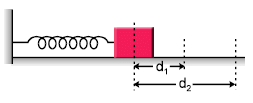
In Resonance tube experiment, if 400 Hz tuning fork is used, the first resonance occurs when length of air column is 19 cm. If the 400 Hz tuning fork is replaced by 1600 Hz tuning fork then to get resonance, the water level in the tube should be further lowered by (take end correction = 1 cm) :
Reasoning Type
Statement-1 : A SHM may be assumed as composition of many SHM's.
Statement-2 : Superposition of many SHM's (along same line) of same frequency will be a SHM.
REASONING TYPE
Statement-1 : When a wave enters from one medium to another, its frequency is not changed.
Statement-2 : Speed of a wave in a medium is property of the source.
A sinusoidal wave is propagating in negative x–direction in a string stretched along x-axis. A particle of string at x = 2m is found at its mean position and it is moving in positive y direction at t = 1 sec. The amplitude of the wave, the wavelength and the angular frequency of the wave are 0.1meter, π/4 meter and 4π rad/sec respectively.
Q. The equation of the wave is :
A sinusoidal wave is propagating in negative x–direction in a string stretched along x-axis. A particle of string at x = 2m is found at its mean position and it is moving in positive y direction at t = 1 sec. The amplitude of the wave, the wavelength and the angular frequency of the wave are 0.1meter, π/4 meter and 4π rad/sec respectively.
Q. The speed of particle at x = 2 m and t = 1sec is :
A sinusoidal wave is propagating in negative x–direction in a string stretched along x-axis. A particle of string at x = 2m is found at its mean position and it is moving in positive y direction at t = 1 sec. The amplitude of the wave, the wavelength and the angular frequency of the wave are 0.1meter, π/4 meter and 4π rad/sec respectively.
Q. The instantaneous power transfer through x=2 m and t= 1.125 sec is :
Matrix - Match Type
For a particle executing SHM along a straight line, match the statements in column-I with statement in column-II. (Note that displacement given in column-I is to be measured from mean position).

Two particles P1 and P2 are performing SHM along the same line about the same mean position. Initially they are at their positive extreme position. If the time period of each particle is 12 sec and the difference of their amplitudes is 12 cm then find the minimum time in seconds after which the separation between the particles become 6 cm.
A weightless rigid rod with a small iron bob at the end is hinged at point A to the wall so that it can rotate in all directions. The rod is kept in the horizontal position by a vertical inextensible string of length 20 cm, fixed at its mid point. The bob is displaced slightly, perpendicular to the plane of the rod and string. Find period of small oscillations of the system in the form second. and fill value of X. (g = 10 m/s2)
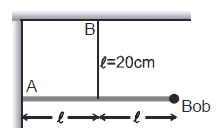
A straight line source of sound of length L = 10m, emitts a pulse of sound that travels radially outward from the source. What sound energy (in mW) is intercepted by an acoustic cylindrical detector of surface area 2.4cm2, located at a perpendicular distance 7m from the source. The waves reach perpendicularly at the surface of the detector. The total power emitted by the source in the form of sound is 2.2 × 104 W.
(Use π = 22/7)
In the figure shown strings AB and BC have masses m and 2m respectively. Both are of same length l. Mass of each string is uniformly distributed on its length. The string is suspended vertically from the ceiling of a room. A small jerk wave pulse is given at the end 'C'. It goes up to upper end 'A' in time 't'. If m = 2 kg, l = , Then find the value of 't' in seconds
For the given reaction the correct reactivity order of H-atoms is :

In the given sequence of reactions which of the following is the correct structure of compound A.
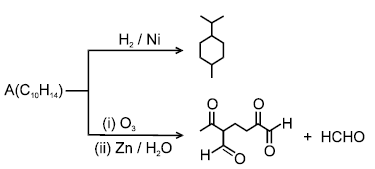
Which of the following is not correctly ordered for resonance stability
Amongst the following compounds select the correct acidic strength order

Arrange the following carbocations in increasing order of stability:

|
356 docs|142 tests
|



